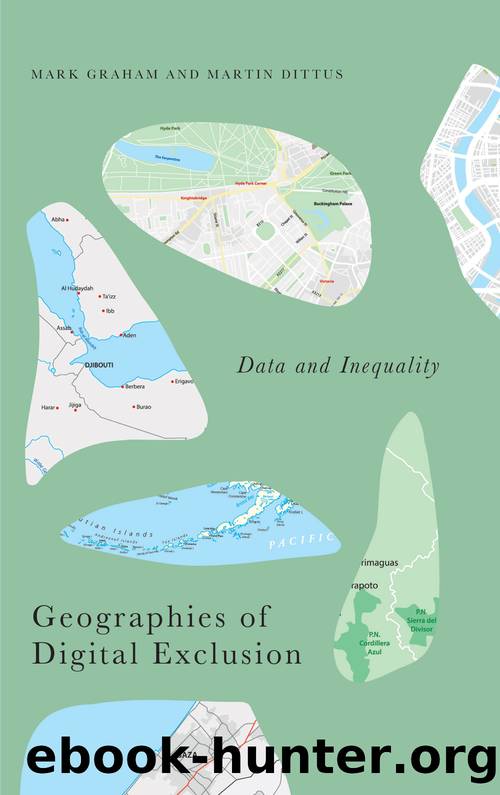Geographies of Digital Exclusion by Mark Graham;Martin Dittus;

Author:Mark Graham;Martin Dittus;
Language: eng
Format: epub
Publisher: Ingram Publisher Services UK
WHO CONTRIBUTES TO WIKIPEDIA?
As we discussed in Chapter 3, the digital representations of Wikipedia are produced by a global network of thousands of volunteers in a collective process of self-motivated volunteer labour. Who are these people, and where in the world are they located? While in previous chapters we have described geographies of information more broadly, we will now take a closer look at the geography of Wikipediaâs contributors.
The demography of social knowledge production
We might expect that Wikipediaâs open and participatory approach to knowledge production would result in a highly equitable social arrangement, with participation coming from a broad range of demographics. However, a surprising and much-discussed aspect of Wikipediaâs open editing model is its strong participation bias: that is, not all populations participate equally. We see this especially in terms of the platformâs gender breakdown. In an early study of highly engaged Wikipedia contributors, only 7 per cent of participants were found to be female (Nov 2007). It was later shown that such a strong gender bias can lead to a topical bias of contributions (Lam et al. 2011). A similar gender divide has been observed for a wide range of other participatory platforms, including both OpenStreetMap and Google MapMaker (Stephens 2013). Across a multitude of surveys, the share of female contributors in Open-StreetMap in particular was found to be as low as 2â5 per cent (Haklay and Budhathoki 2010; Y.-W. Lin 2011; Stark 2011; Lechner 2011; Budhathoki and Haythornthwaite 2013; Neis and Zielstra 2014).
This stark gender divide was likely identified early on because it is relatively easy to observe. By comparison, less information is available about other dimensions of social difference. The first large demographic survey of the Wikipedia community (including both editors and readers) was launched in 2008 by the Wikimedia Foundation and the United Nations University (Glott, Schmidt and Ghosh 2010). Over the course of a few months the survey drew almost 180,000 respondents, most of them participants in the English-, Russian-, Spanish- or German-language editions of Wikipedia. While a full third of respondents stated that they contribute actively to Wikipedia, the remaining two-thirds considered themselves to be readers. Half the surveyâs respondents were younger than 22 years, possibly reflecting that the Wikipedia project itself was still quite new at the time, having only been launched in 2001. Perhaps corresponding to this relatively young age, around half the respondents stated that secondary education was their highest educational attainment to date, though respondents overall appeared to be well-educated: a quarter had completed an undergraduate degree, and a fifth a graduate or postgraduate degree. The survey also supported the earlier observation of a gender divide: only 13 per cent of respondents were women. This initial Wikipedia survey did not include questions about employment status and economic circumstances, however it is notable that when it asked about reasons not to make a donation to Wikipedia, almost half the respondents stated that they could not afford to make one. When respondents who identified as readers were asked why they did
Download
This site does not store any files on its server. We only index and link to content provided by other sites. Please contact the content providers to delete copyright contents if any and email us, we'll remove relevant links or contents immediately.
Optimizing Microsoft Azure Workloads by Rithin Skaria(6546)
Kubernetes in Production Best Practices by Aly Saleh and Murat Karslioglu(6283)
Cloud Computing Demystified for Aspiring Professionals by David Santana(5391)
Zed Attack Proxy Cookbook by Ryan Soper & Nestor N Torres & Ahmed Almoailu(4832)
Google Cloud for Developers: Write, migrate, and extend your code by leveraging Google Cloud by Hector Parra Martinez(3706)
AWS Observability Handbook by Phani Kumar Lingamallu & Fabio Braga de Oliveira(3321)
Mastering Cyber Intelligence by Jean Nestor M. Dahj;(3294)
The Road to Azure Cost Governance by Paola E. Annis Giuliano Caglio(2820)
Microsoft 365 Fundamentals Guide by Gustavo Moraes and Douglas Romão(2266)
Agile Security Operations: Engineering for Agility in Cyber Defense, Detection, and Response by Hinne Hettema(1910)
Cloud Identity Patterns and Strategies: Design enterprise cloud identity models with OAuth 2.0 and Azure Active Directory by Giuseppe Di Federico Fabrizio Barcaroli(1909)
Bootstrapping Service Mesh Implementations with Istio by Anand Rai(1796)
The Road to Azure Cost Governance: Techniques to tame your monthly Azure bill with a continuous optimization journey for your apps by Paola E. Annis Giuliano Caglio(1276)
Agile Security Operations: Engineering for agility in cyber defense, detection, and response by Hinne Hettema(1212)
Zed Attack Proxy Cookbook: Hacking tactics, techniques, and procedures for testing web applications and APIs by Ryan Soper Nestor N Torres Ahmed Almoailu(1211)
Linux Administration Best Practices: Practical Solutions to Approaching the Design and Management of Linux Systems by Scott Alan Miller(1143)
DevSecOps in Practice with VMware Tanzu: Build, run, and manage secure multi-cloud apps at scale on Kubernetes with the Tanzu portfolio by Parth Pandit Robert Hardt(1094)
Terraform for Google Cloud Essential Guide by Bernd Nordhausen(900)
Becoming KCNA Certified by Dmitry Galkin(889)
